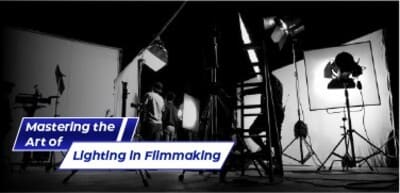Mastering the Art of Lighting in Filmmaking
Mastering the Art of Lighting in Filmmaking: Illuminating the Cinematic World
Lighting in filmmaking, lighting plays a crucial role in setting the mood, enhancing visuals, and captivating audiences. It is a fundamental aspect that can make or break a scene, bringing life and depth to the storytelling. From the subtle nuances of shadows to the vibrant hues of colour, lighting can transform a simple shot into a visually captivating masterpiece.
The art of lighting involves more than just illumination—it is about crafting depth, contrast, and texture. Filmmakers strategically use different types of lighting in filmmaking to create atmosphere and evoke emotions.


Why is lighting so important?
Creating Atmosphere and Mood
Effective lighting sets the tone of a scene, evoking emotions and enhancing the narrative. Whether it's a dark and mysterious atmosphere, a warm and intimate setting, or a high-energy action sequence, the strategic use of lights can immerse viewers in the story and enhance their emotional connection. The interplay between light and shadow can evoke a sense of tension, highlight moments of suspense, or create a serene ambience that resonates with the audience.
Shaping Visual Composition
Lighting allows filmmakers to control what the audience sees within the frame. It helps guide the viewer's attention to the key elements, emphasising important characters or objects and directing the flow of the story. By manipulating the intensity, direction, and colour of light, filmmakers can create visually stunning compositions that enhance the overall storytelling. A well-lit scene can draw the audience's gaze to a character's facial expression, revealing their inner emotions, or accentuate the beauty of a scenic landscape, transporting viewers to another world.
What are the different types of lighting in filmmaking?
Lighting in filmmaking involves various techniques that shape the visual tone, define the mood, and enhance the cinematic experience.
Key Light
The key light is the primary light source in a scene, usually positioned to one side of the subject. It provides the main illumination, highlighting the subject's features and adding depth to the shot. The intensity and angle of the key light can significantly impact the mood and shape the character's appearance. For example, a harsh key light with strong shadows can create a sense of drama and mystery, while a soft key light can produce a more gentle and flattering effect.
Fill Light
The fill light softens the shadows created by the key light, balancing the overall Lighting in filmmaking. It reduces the contrast and provides a more even lighting distribution, ensuring that details are visible in the shadows while maintaining a natural and realistic look. The fill light is essential in preventing overly dark or underexposed areas, helping to create a visually pleasing and well-exposed image.
Back Light
Placed behind the subject and aimed towards the camera, the backlight separates the subject from the background, creating depth and visual interest. It adds a halo-like glow around the subject's edges, making them stand out and adding a three-dimensional quality to the shot. The backlight can create a sense of depth and separation, enhancing the visual separation of the subject from the background and adding a touch of cinematic magic.
Sidelight
Sidelight comes from the side of the subject and creates dramatic contrasts between light and shadow. It adds depth, texture, and a sense of volume to the subject, enhancing their features and creating a visually striking effect. In types of lighting in filmmaking, Sidelight sculpts the subject's face, emphasising their facial structure and creating a visually captivating image.
Practical Light
Practical lights refer to light sources visible within the frame, such as lamps, candles, or streetlights. They not only provide illumination but also contribute to the realism and atmosphere of the scene. This technique is widely used in the art of filmmaking to create believable environments. making it feel more authentic and believable. Practical lights can add a sense of familiarity and relatability to the story, creating a connection between the audience and the on-screen world.
Motivated lighting
Motivated lighting relies on the idea that light sources in the scene possess a logical and believable origin. It aims to mimic real-world lighting conditions, such as sunlight streaming through a window or a flashlight in a dark room. In filmmaking, this technique adds a naturalistic feel to the scene and enhances the audience's immersion. By aligning the lighting with the story's setting and context, filmmakers can create a sense of authenticity and enhance the overall realism of the film.
Diffusion
Diffusion refers to the process of softening and scattering light, reducing harsh shadows and creating a more even and gentle illumination. Achieving diffusion can be done through various methods, such as utilising diffusing materials or placing filters in front of the lights. Diffusion helps create a flattering look, especially for close-ups, creating a sense of mystery or ambiguity or scenes requiring a soft and dreamy atmosphere. making it an essential tool in the art of lighting.
Conclusion
Lighting in filmmaking is vital for setting the mood, enhancing visuals, and captivating audiences. Different lighting techniques, such as key lights, fill lights, backlights, sidelights, practical lights, motivated lighting, and diffusion, are used to create atmosphere, shape composition, and add realism. Seamedu School of Pro-Expressionism offers comprehensive courses in filmmaking, providing industry-focused education and hands-on experience in filmmaking and lighting techniques. By enrolling in Seamedu's program, students can unleash their potential as visual storytellers, mastering the art of lighting and creating captivating cinematic experiences.


CATEGORIES
- MBA Program
- Data Science and Analytics
- Cloud Computing
- Data Analytics and Business Intelligence
- AI and Digital Systems
- Cyber Security and Digital Forensics
- Business Analytics & Intelligence
- Banking & Financial Services
- International Business
- Digital Marketing
- Research Paper
- Media & Entertainment
- Media Management
- Journalism and Media Production
- Media & Information Technology
- Visual Communication
- Game Development
- Sound Engineering
- Game Art & Design
- Photography
- Film Making
- Animation & VFX
Are you aspiring to become a proficient Film Making professional?
Look no further; we are committed to nurturing the potential of young minds. Are you ready to enhance your skills?


